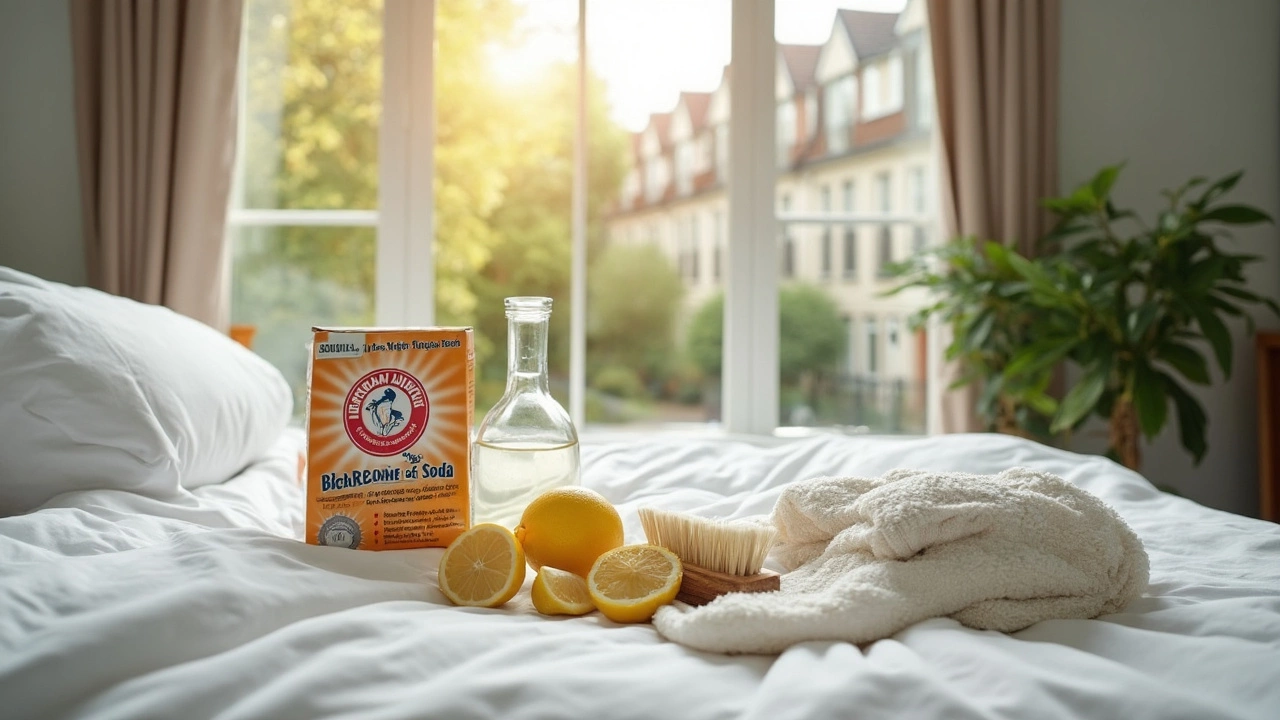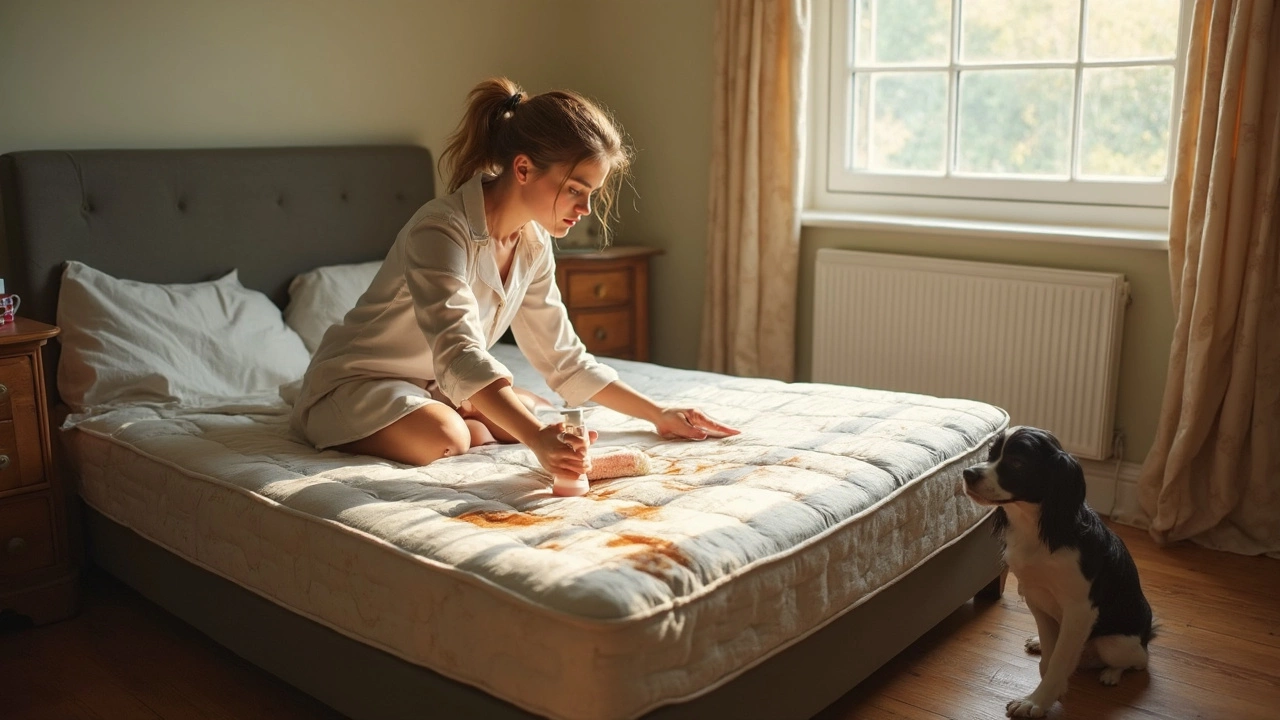If you’ve ever peeled back your sheets and been greeted by a constellation of ugly stains on your mattress, you know the sinking feeling that comes next. Maybe it’s from spilled coffee in the morning rush, a dog that loves muddy adventures (looking at you, Charlie), or that stomach flu attack from last winter. Mattresses soak it all in—literally. The bad news? Most stains don’t just fade with time. The good news? You really can save your mattress, no matter how wrecked it looks. Knowing what causes these stubborn stains is the first step, because some marks are just tougher than others.
Why Mattresses Get Stained and What That Means for Cleaning
Messes on mattresses aren’t just from lazy eating habits or shedding pets. Mattresses face a lot of unseen daily abuse. Sweat, oils from your skin, and accidental spills are only the start. Over time, these seep down and cling to the fabric and padding underneath. Those yellowish stains that seem to show up out of nowhere? Most of the time, they’re from body fluids like sweat and drool, mixing with dust and dead skin.
Here’s a basic breakdown of what kind of stains you’ll see and what causes them:
- Food and drink stains – Coffee, wine, or soda spills turn into impressive blotches that can smell if not cleaned right away.
- Biological stains – Things like urine, blood, vomit, or even pet accidents tend to be the toughest to kick. These can actually change color as they dry and encourage mold or bacteria if they sink in too far.
- Dirt and sweat marks – These don’t always look as dramatic, but they build up slowly and can leave your mattress smelling less than fresh.
- Mold and mildew – In humid spaces or after spills that don’t dry fast enough, mattresses can develop deep-set, musty stains. These are not just ugly but unhealthy.
If you’ve got a memory foam mattress, the situation can feel even trickier. These absorb liquids far faster than traditional spring mattresses. Once a stain sets on foam, it clings on for dear life, so fast action always helps. But, don’t panic: even set-in stains can usually be lifted if you know a few pro-level tricks.
According to a 2023 survey by the International Sleep Products Association, about 1 in 3 people will try to clean their mattress themselves before thinking about replacing it. If you can relate, you’re already saving money—mattresses aren’t cheap. Learning how to do it right is worth the effort, especially when you think about how much time you spend lolling around in bed.
The Real Deal on Deep Cleaning Techniques That Work
Scrubbing a mattress isn’t like tossing your T-shirt in the washer. The biggest enemy isn’t just the stain—it’s letting water soak in, which can create bigger problems. So, you want to clean deep, but also smart.
Professional cleaners use steps similar to these at home:
- Strip the bed and vacuum: Get rid of all bedding, including pads and protectors. Use a strong vacuum with a clean upholstery attachment to lift out loose dirt, crumbs, pet hair, and dead skin. Go over seams and crevices; that’s where dust loves to hide.
- Spot-treat stains: Mix a simple stain-fighting solution—one part white vinegar, one part cool water, and a few drops of liquid laundry detergent. Dab (don’t pour!) the solution directly onto the stains with a white cloth. For set-in stains, sprinkle on a little baking soda first; this helps lift and deodorize as you go.
- Bust out the enzyme cleaner: For organic messes like blood, urine, or vomit, enzyme cleaners work wonders. These break down the proteins in the stain for easier cleaning. Just spray, wait 15 minutes, blot, and repeat as needed. Always test any cleaner first on a hidden patch so you don’t end up bleaching the fabric.
- Rinse and blot: Use a lightly damp cloth—just water this time—to gently ‘rinse’ the spot, removing any leftover cleaner. Blot (press down and lift) instead of scrubbing to avoid spreading the stain or pushing moisture deeper.
- Dry thoroughly: Dampness is how mattresses end up smelling like a gym locker room, or worse, growing mold. Use a fan, open a window, or bust out a hair dryer on cool setting to help dry things fast. Never make the bed until the mattress is totally dry to the touch.
If you want extra firepower, here are a few specific tricks for different stains:
- Blood: Hydrogen peroxide (3%) can work, but always use sparingly, dab it on with a Q-tip or small cloth and blot up as it bubbles. It can bleach fabrics, so only try this on light-colored mattresses.
- Urine (including pet mess): After the enzyme cleaner, baking soda left overnight will finish the job and kill odors. Just vacuum it away in the morning.
- Wine and coffee: Blot up as much as you can right away, then treat with club soda or the vinegar mix above.
If all else fails and the stains just won’t quit, cover the mattress with a waterproof protector. This won’t erase the problem, but it buys you time while you figure out a replacement, plus it keeps future stains out. The pros say even the most trashed mattresses can often be salvaged if you act fast and use the right method, so don’t lose hope.

Mattress Odor Removal: How To Make It Smell Fresh Again
Mattress odors are a huge deal, and honestly, even when stains are gone, smells can linger. It’s usually from the same stuff that causes stains—body sweat, pet accidents, or spills that never fully dried out. With strong odors, it’s not enough to just mask with air freshener. You have to get rid of the problem at the source.
Here’s how to freshen things up:
- Generously sprinkle baking soda over the entire mattress. Let it sit for at least four hours, or overnight—this gives it time to pull in odors like a sponge.
- While the baking soda is at work, open windows if you can. Sunlight not only helps with drying but it also naturally kills some germs and bacteria that create bad smells.
- Vacuum the whole surface completely once the baking soda has done its magic. Use an upholstery attachment to pull the powder and any trapped funk away.
- If stubborn odors stick around, try spritzing the mattress lightly with a 50/50 mix of white vinegar and water. It might smell like a salad briefly, but once it dries, the sour smell disappears (and usually takes the bad stuff with it).
- Activated charcoal packs placed under the bed or in the corners of your room also help trap any lingering mustiness—these are the same things people use in litter boxes or closets to beat odors.
Sometimes, the secret for chronic odor involves professional ozone machines or steam cleaners, especially in homes with lots of pets or recurring accidents. When all else fails, these deep treatments break up odor molecules that just don’t want to quit.
People often forget how much our senses connect to sleep and rest. Bad smells = bad nights. If you share your bed with a pet like I do with Charlie, you know accidents happen. Keeping odor at bay means you and your four-legged friend don’t have to fight over who gets the couch.
Long-Term Protection: Keeping Your Mattress Cleaner, Longer
Once you’ve put in all the work to rescue your mattress, the last thing you want is for it to get wrecked again next week. Routine care is the secret here. Nothing has to be fancy; just a few tweaks to your habits will do the trick.
- Always use a protective, waterproof mattress cover. These aren’t just for toddler beds—you can get slim, comfy versions designed for grown-ups that block sweat, spills, and pet messes. Wash them monthly for best results.
- Change your sheets at least every two weeks. This stops grime, sweat, and shedding from building up and seeping through to the mattress itself.
- Vacuum your mattress every second month. Even if you don’t see much on the surface, dust mites, pet dander, and dead skin all pile up extra fast, especially if you sleep with a dog or cat.
- If you spill something—anything—act fast. The longer it sits, the deeper it travels. Even just blotting up as much liquid as you can with a towel makes a difference until you can do a thorough clean.
- Try to keep your bedroom air dry and airy. Too much humidity makes for the perfect playground for mold and mildew. A simple dehumidifier is a lifesaver in muggy weather or if you live in a basement apartment.
This might surprise you, but the average mattress can weigh twice as much after ten years because of all the gunk built up inside—think sweat, skin, dust, mites, and yes, the aftermath of every coffee spill and pet mishap. With regular protection, you’ll help keep your mattress from turning into a science experiment.
Just for fun, check out this quick breakdown:
| Common Stain Type | Best Cleaner | Dry Time (avg) |
|---|---|---|
| Urine (human/pet) | Enzyme cleaner + baking soda | 4-6 hrs |
| Blood | Hydrogen peroxide | 2-3 hrs |
| Coffee/wine | Vinegar solution + baking soda | 3-4 hrs |
| Sweat/body oils | Upholstery shampoo | 2-3 hrs |
Most stains aren’t the end of the world, just a call to action. If you treat your mattress right, it’ll pay you back with nights of better sleep, less worry, and more space for you (or your pet) to relax. Trust me, after wrangling Charlie’s muddy paw prints and a few accidental “presents,” I’ve seen almost every kind of mattress disaster. They really are fixable with some patience, a little muscle, and the right technique. Sleep tight!
